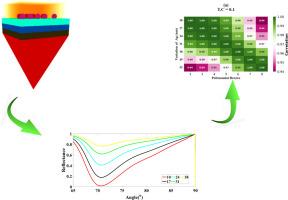Machine learning-enhanced Kretschmann configuration plasmonic biosensor for real-time brain tumor biomarker detection
IF 6.3
2区 材料科学
Q2 CHEMISTRY, PHYSICAL
引用次数: 0
Abstract
Brain tumors present significant diagnostic challenges due to delayed symptom manifestation and inadequate early detection methods. Conventional imaging techniques (MRI, CT) lack molecular specificity, while spectroscopic approaches typically exhibit limited sensitivity. In this study, we developed a plasmonic biosensor utilizing Kretschmann configuration with Au/Ag/WS₂ multilayers and graphene for real-time, label-free brain tumor biomarker detection. The sensor exploits surface plasmon resonance amplification in the infrared spectrum to identify distinct molecular vibrational signatures of tumor-associated biomolecules, including altered proteins and lipids.Numerical simulations demonstrate exceptional performance metrics: sensitivity of 804.020°/RIU, detection limit of 0.003 RIU, and figure of merit of 164.086 RIU⁻¹ across refractive indices spanning 1.3333–1.4833, encompassing varied biomarker concentrations. XGBoost machine learning optimization enhances detection accuracy and reliability. Correlation analyses between predicted and Simulation absorption values yield R² coefficients of 88–94 % across WS₂ thickness variations and Ag/Au layer parameters. Under optimized conditions, maximum R² values achieve 94–100 % for Ag layers and 96–100 % for Au layers, confirming robust predictive capability and superior performance under optimal operating parameters. This integrated plasmonic-ML platform represents a promising advancement toward sensitive, early-stage brain tumor diagnosis.

用于实时脑肿瘤生物标志物检测的机器学习增强Kretschmann配置等离子体生物传感器
由于症状表现迟缓和早期检测方法不足,脑肿瘤的诊断面临重大挑战。传统的成像技术(MRI, CT)缺乏分子特异性,而光谱方法通常表现出有限的灵敏度。在这项研究中,我们开发了一种利用Au/Ag/WS 2多层和石墨烯的Kretschmann结构的等离子体生物传感器,用于实时,无标记的脑肿瘤生物标志物检测。该传感器利用红外光谱中的表面等离子体共振放大来识别肿瘤相关生物分子的不同分子振动特征,包括改变的蛋白质和脂质。数值模拟显示了卓越的性能指标:804.020°/RIU的灵敏度,0.003 RIU的检测限,以及164.086 RIU的优点-跨越1.3333-1.4833的折射率,包括不同的生物标志物浓度。XGBoost机器学习优化提高了检测的准确性和可靠性。预测值与模拟值之间的相关性分析表明,在不同的WS厚度变化和Ag/Au层参数下,R²系数为88 - 94%。在优化条件下,银层和金层的最大R²值分别达到94 - 100%和96 - 100%,具有较强的预测能力和较好的预测性能。这种集成的等离子体- ml平台代表了对敏感的早期脑肿瘤诊断的有希望的进步。
本文章由计算机程序翻译,如有差异,请以英文原文为准。
求助全文
约1分钟内获得全文
求助全文
来源期刊

Surfaces and Interfaces
Chemistry-General Chemistry
CiteScore
8.50
自引率
6.50%
发文量
753
审稿时长
35 days
期刊介绍:
The aim of the journal is to provide a respectful outlet for ''sound science'' papers in all research areas on surfaces and interfaces. We define sound science papers as papers that describe new and well-executed research, but that do not necessarily provide brand new insights or are merely a description of research results.
Surfaces and Interfaces publishes research papers in all fields of surface science which may not always find the right home on first submission to our Elsevier sister journals (Applied Surface, Surface and Coatings Technology, Thin Solid Films)
 求助内容:
求助内容: 应助结果提醒方式:
应助结果提醒方式:


